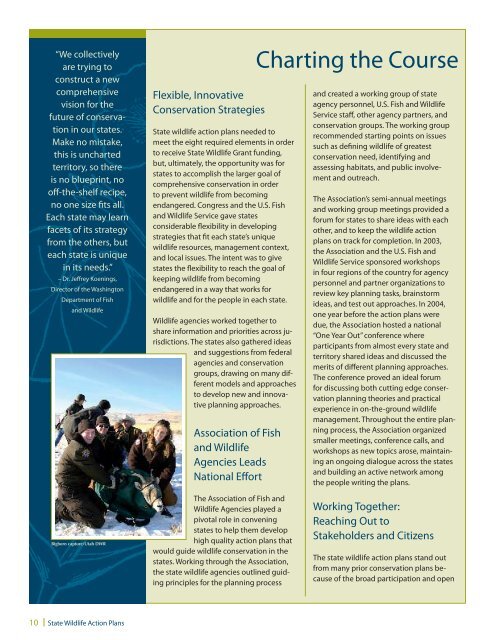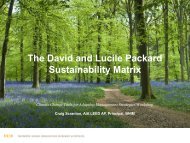State WAP Revised 8.29.06.indd - Teaming With Wildlife
State WAP Revised 8.29.06.indd - Teaming With Wildlife
State WAP Revised 8.29.06.indd - Teaming With Wildlife
You also want an ePaper? Increase the reach of your titles
YUMPU automatically turns print PDFs into web optimized ePapers that Google loves.
“We collectively<br />
are trying to<br />
construct a new<br />
comprehensive<br />
vision for the<br />
future of conservation<br />
in our states.<br />
Make no mistake,<br />
this is uncharted<br />
territory, so there<br />
is no blueprint, no<br />
off-the-shelf recipe,<br />
no one size fits all.<br />
Each state may learn<br />
facets of its strategy<br />
from the others, but<br />
each state is unique<br />
in its needs.”<br />
– Dr. Jeffrey Koenings,<br />
Director of the Washington<br />
Department of Fish<br />
and <strong>Wildlife</strong><br />
Flexible, Innovative<br />
Conservation Strategies<br />
<strong>State</strong> wildlife action plans needed to<br />
meet the eight required elements in order<br />
to receive <strong>State</strong> <strong>Wildlife</strong> Grant funding,<br />
but, ultimately, the opportunity was for<br />
states to accomplish the larger goal of<br />
comprehensive conservation in order<br />
to prevent wildlife from becoming<br />
endangered. Congress and the U.S. Fish<br />
and <strong>Wildlife</strong> Service gave states<br />
considerable flexibility in developing<br />
strategies that fit each state’s unique<br />
wildlife resources, management context,<br />
and local issues. The intent was to give<br />
states the flexibility to reach the goal of<br />
keeping wildlife from becoming<br />
endangered in a way that works for<br />
wildlife and for the people in each state.<br />
<strong>Wildlife</strong> agencies worked together to<br />
share information and priorities across jurisdictions.<br />
The states also gathered ideas<br />
and suggestions from federal<br />
agencies and conservation<br />
groups, drawing on many different<br />
models and approaches<br />
to develop new and innovative<br />
planning approaches.<br />
Association of Fish<br />
and <strong>Wildlife</strong><br />
Agencies Leads<br />
National Effort<br />
Charting the Course<br />
and created a working group of state<br />
agency personnel, U.S. Fish and <strong>Wildlife</strong><br />
Service staff, other agency partners, and<br />
conservation groups. The working group<br />
recommended starting points on issues<br />
such as defining wildlife of greatest<br />
conservation need, identifying and<br />
assessing habitats, and public involvement<br />
and outreach.<br />
The Association’s semi-annual meetings<br />
and working group meetings provided a<br />
forum for states to share ideas with each<br />
other, and to keep the wildlife action<br />
plans on track for completion. In 2003,<br />
the Association and the U.S. Fish and<br />
<strong>Wildlife</strong> Service sponsored workshops<br />
in four regions of the country for agency<br />
personnel and partner organizations to<br />
review key planning tasks, brainstorm<br />
ideas, and test out approaches. In 2004,<br />
one year before the action plans were<br />
due, the Association hosted a national<br />
“One Year Out” conference where<br />
participants from almost every state and<br />
territory shared ideas and discussed the<br />
merits of different planning approaches.<br />
The conference proved an ideal forum<br />
for discussing both cutting edge conservation<br />
planning theories and practical<br />
experience in on-the-ground wildlife<br />
management. Throughout the entire planning<br />
process, the Association organized<br />
smaller meetings, conference calls, and<br />
workshops as new topics arose, maintaining<br />
an ongoing dialogue across the states<br />
and building an active network among<br />
the people writing the plans.<br />
Bighorn capture/Utah DWR<br />
The Association of Fish and<br />
<strong>Wildlife</strong> Agencies played a<br />
pivotal role in convening<br />
states to help them develop<br />
high quality action plans that<br />
would guide wildlife conservation in the<br />
states. Working through the Association,<br />
the state wildlife agencies outlined guiding<br />
principles for the planning process<br />
Working Together:<br />
Reaching Out to<br />
Stakeholders and Citizens<br />
The state wildlife action plans stand out<br />
from many prior conservation plans because<br />
of the broad participation and open<br />
10<br />
<strong>State</strong> <strong>Wildlife</strong> Action Plans




